Accessories
Check out our full lineup of yoga accessories to help you with your daily meditation practice and fitness goals...
Try our new Cork Yoga Brick for soft but solid support
Check out our full lineup of yoga accessories to help you with your daily meditation practice and fitness goals...

How to Start a Cleaning Product Line (Step-by-Step)
March 26, 2025 4 min read
By James Dudra – Founder of Filling Factory | 20+ Years of Product Development Experience
Starting a cleaning product line can feel like trying to drink from a firehose. Between product development, packaging, manufacturing, and compliance, there’s a lot to get right — and a lot that can go sideways fast.
But with the right roadmap, it’s totally doable. Whether you’re a first-time founder or a seasoned entrepreneur branching into cleaning products, this guide will walk you through every key step — from concept to shelf.
Table of Contents
- 1. Define Your Segment
- 2. Establish Your Brand
- 3. Choose a Hero SKU
- 4. Decide How You’ll Manufacture
- 5. Secure Your Formula
- 6. Plan Your Packaging Early
- 7. Design Labels & Ensure Compliance
- 8. Coordinate Production
- 9. Final Steps: Safety, Compliance, and Insurance
- Key Takeaways
- Final Thoughts
1. Define Your Segment
Before you mix a single batch or sketch a label, get clear on your target segment. Are you launching a household spray? An industrial degreaser? A boutique line of eco-friendly car cleaners?
Three major categories to consider:
- Household: Kitchen, bathroom, all-purpose cleaners
- Automotive: Interior detailers, wheel/tire cleaners, ceramic sprays
- Industrial/Commercial: Janitorial supplies, institutional cleaners, bulk formats
Each niche has different standards, buying behavior, and distribution channels. A household product might need eye-catching packaging for Target shelves. A commercial product might require EPA registration and drums instead of bottles.
Pro Tip: This decision impacts everything — formulation, packaging, compliance, even how you market and sell.

2. Establish Your Brand
You don’t need a million-dollar brand identity to get started — but you do need the basics locked down:
- Name + Domain: Choose a name with an available .com and clear trademark path. Run a USPTO trademark search.
- Logo + Visual Identity: Use freelancers or platforms like 99designs or Upwork to create your logo and brand system.
- Trademark Check (Again): Skip this and you risk cease-and-desist letters. Always confirm availability.
A solid brand foundation will save you from major rework down the line — and help you show up consistently across packaging, web, and retail.
3. Choose a Hero SKU
Don’t try to launch with five products. Start with one hero SKU — the one thing you want to be known for.
Examples:
- Clorox → Bleach
- Dawn → Dish Soap
Your hero product should solve a clear problem and be easy to describe in one sentence. It helps build trust with early customers and simplifies everything — manufacturing, inventory, marketing.

4. Decide How You’ll Manufacture
Two main paths:
A) Use a Chemical Co-Packer
- Fastest way to scale
- Use their staff, equipment, and sometimes even stock formulas
- Must meet their MOQs (minimum order quantities)
B) Manufacture In-House
- Great for bootstrapping and small runs
- Gives full control
- Requires equipment, space, and safety processes
Be honest about your budget and resources. If you're testing demand, self-manufacturing might be the way to go. If you’ve got retail contracts, co-packers can get you to market faster.

5. Secure Your Formula
Two options:
Use a Co-Packer’s Stock Formula
- Fastest route to market
- Low development cost
- But not proprietary — other brands can use the same formula
Hire a Formulator to Create a Custom Formula
- 100% ownership and flexibility
- Requires more time and budget
- Needs testing and regulatory support
Make sure your formulator can handle:
- Stability + compatibility testing
- Ingredient disclosure with CAS numbers
- Claims substantiation and compliance
- Certifications like USDA BioPreferred or SaferChoice
6. Plan Your Packaging Early
Packaging isn’t just about aesthetics — it impacts costs, production, storage, and shipping.
- Budget: Start with stock bottles and sprayers unless you can meet 50k+ unit MOQs
- Formula Compatibility: Test packaging for reactivity before scaling
- Sales Channel Requirements: Case packs differ for Amazon vs. retail stores
Get samples early and validate every component — closures, seals, sprayers, labels.
7. Design Labels & Ensure Compliance
Once you have your packaging, get the dieline file from your supplier and work with a designer who understands regulatory and retail layout standards.
Compliance Checklist:
- Meets CPSC, FTC, and EPA guidelines
- Truthful, substantiated claims (especially for "green" terms)
- Legally required warnings and formatting
If you’re unsure about what’s allowed, hire a regulatory consultant or legal expert. Compliance mistakes can be expensive.

8. Coordinate Production
If Using a Co-Packer:
- Confirm material sourcing (bottles, caps, labels, raw ingredients)
- Track lead times and follow up weekly
- Attend first production run, if possible
If Manufacturing In-House:
- Create a clean, organized workspace
- Implement PPE and sanitation protocols
- Refine your bottling, labeling, and shipping workflows
This is where the idea becomes reality. Attention to detail matters — from lot codes to packing orientation.
9. Final Steps: Safety, Compliance, and Insurance
- Safety Data Sheets (SDS): Required for B2B sales and online transparency
- Liability Insurance: Protect your company and assets
- Ingredient Disclosure: California’s SB-258 mandates online ingredient transparency — more states are adopting similar laws
Key Takeaways
- 🎯 Focus on one hero product to start
- ⚖️ Choose your manufacturing model based on resources and growth plans
- 🧪 Be meticulous about formulation, packaging, and compliance
- 🔐 Own your formula if you want long-term flexibility
- 🛡️ Don’t skip safety and regulatory safeguards — they protect your brand
Final Thoughts
Launching a cleaning product line is a serious undertaking — but incredibly rewarding when done right. You’ll face tough decisions, learn quickly, and build something that reflects your values and vision.
Need help getting started? I offer a free 20-minute consultation to serious founders. Whether you need formulation advice, co-packer referrals, or just a sanity check, I’m here to help.
Subscribe
Sign up to get the latest on sales, new releases and more …
